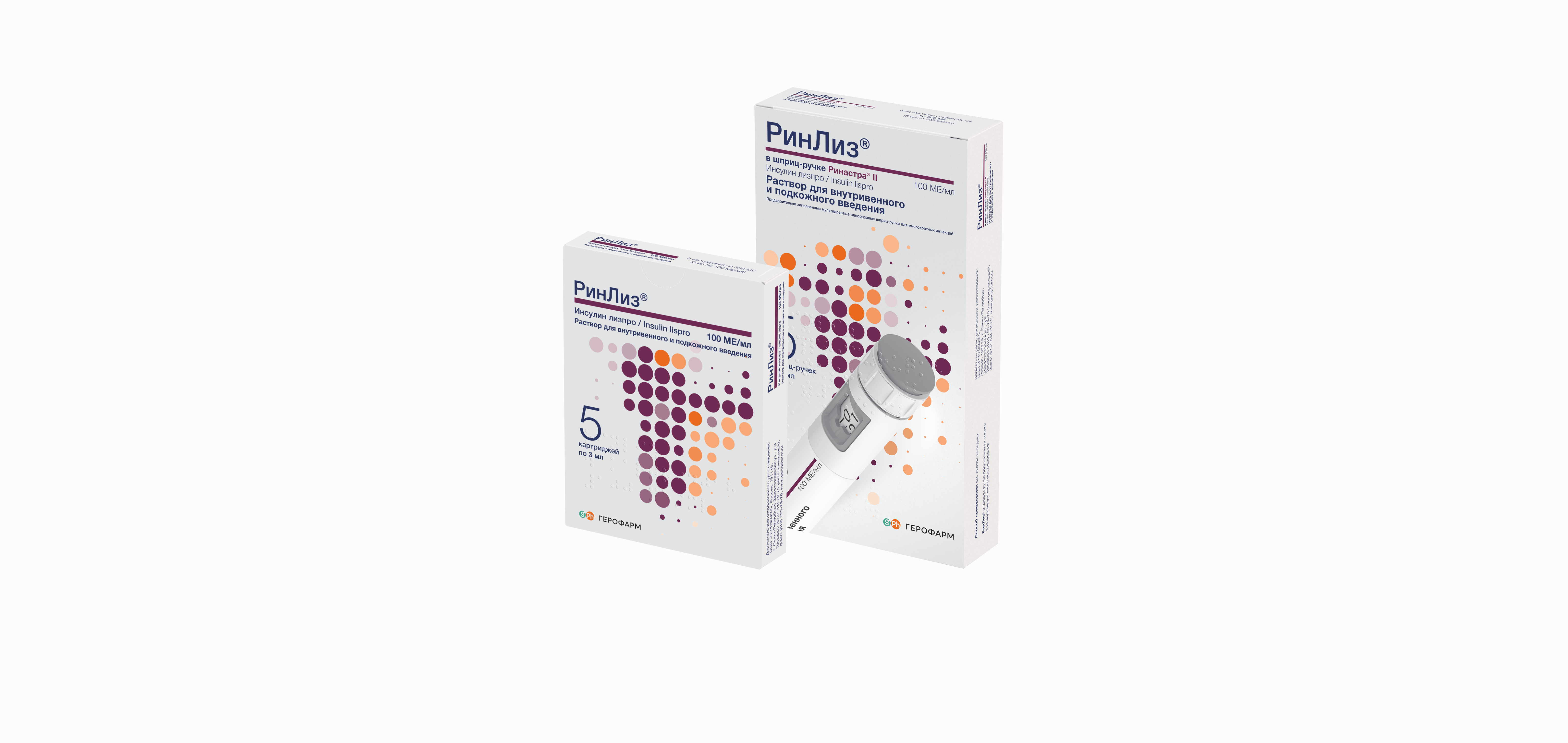RinLis® (insulin lispro)
- Widely used fast acting insulin analogue
- Characterised by reverse lysine and priline residues on amino acid sequence in the insulin amino acid chain
- Fast absorption from subcutaneous injections sites
- Onset of action after subcutaneous administrationin -15 min
- Maximum action - in 0.5–2.5 hours
- Duration of action 3–4 hours
This drug is a prescribed medicine. It can be dispensed on a doctor's prescription only. There are contraindications. Please read the patient information leaflet. Do not use the medicinal agent if it was not prescribed by your treating physician. Always follow the patient information leaflet and your doctor’s recommendations.
Pharmacokinetic properties
The pharmacokinetics of insulin lispro reflect a compound that is rapidly absorbed, and achieves peak blood levels 30 to 70 minutes following subcutaneous injection. When considering the clinical relevance of these kinetics, it is more appropriate to examine the glucose utilization curves/
Renal impairment
Insulin lispro maintains more rapid absorption when compared to soluble human insulin in patients with renal impairment. In patients with type 2 diabetes over a wide range of renal function the pharmacokinetic differences between insulin lispro and soluble human insulin were generally maintained and shown to be independent of renal function.
Hepatic impairment
Insulin lispro maintains more rapid absorption and elimination when compared to soluble human insulin in patients with hepatic impairment.
Trade name: RinLis®
International nonproprietary name (INN): insulin lispro
Dosage form: solution for subcutaneous and intravenous injections in 3 ml cartridges and disposable insulin pen
ATC-code: А10АB04
Pharmacodynamic properties
Pharmaco-therapeutic group: Drugs used in diabetes. Insulins and analogues for injection, fast-acting.
RinLis is a biosimilar to Humalog.
The primary activity of insulin lispro is the regulation of glucose metabolism.
Insulin lispro has a rapid onset of action (approximately 15 minutes), thus allowing it to be given closer to a meal (within zero to 15 minutes of the meal) when compared to regular insulin (30 to 45 minutes before). Insulin lispro takes effect rapidly and has a shorter duration of activity (2 to 5 hours) when compared to regular insulin.
Clinical trials in patients with type 1 and type 2 diabetes have demonstrated reduced postprandial hyperglycaemia with insulin lispro compared to soluble human insulin.
Instructions for use and handling
RinLis, 100 units/ml, solution for injection in cartridge
To prevent the possible transmission of disease, each cartridge must be used by one patient only, even if the needle on the delivery device is changed.
Cartridges containing RinLis should only be used with the following pen-injectors:
—
Pen-injector
for insulin injections HumaPen Savvio («Eli Lilly and Company», the USA)
—
Pen-injector
for insulin injections RinsaPen I («Ypsomed AG», Switzerland)
—
Pen-injector
for insulin injections RinsaPen II («Ypsomed AG», Switzerland)
These cartridges should not be used with any other
reusable pen-injectors, since dose accuracy has been proved only for
above-mentioned pen-injectors.
Not all of these pen-injectors could be available in
your country.
RinLis, 100 units/ml, solution for injection in a pre-filled pen (Rinastra® II)
To prevent the possible transmission of disease, each pre-filled
pen must be used by one patient only, even if the needle on the delivery device
is changed.
Interaction with other medicinal products and other forms of interaction
Insulin requirements may be increased by substances with hyperglycaemic activity, such as oral contraceptives, corticosteroids, or thyroid replacement therapy, danazol, beta2 stimulants (such as ritodrine, salbutamol, terbutaline).
Insulin requirements may be reduced in the presence of substances with hypoglycaemic activity, such as oral hypoglycaemics, salicylates (for example, acetylsalicylic acid), sulpha antibiotics, certain antidepressants (monoamine oxidase inhibitors, selective serotonin reuptake inhibitors), certain angiotensin converting enzyme inhibitors (captopril, enalapril), angiotensin II receptor blockers, beta-blockers, octreotide or alcohol.
The physician should be consulted when using other medications in addition to RinLis®.
Fertility, pregnancy and lactation
Pregnancy
Data on a large number of exposed pregnancies do not indicate any adverse effect of insulin lispro on pregnancy or on the health of the foetus/newborn.
It is essential to maintain good control of the insulin-treated (insulin-dependent or gestational diabetes) patient throughout pregnancy. Insulin requirements usually fall during the first trimester and increase during the second and third trimesters. Patients with diabetes should be advised to inform their doctor if they are pregnant or are contemplating pregnancy. Careful monitoring of glucose control, as well as general health, is essential in pregnant patients with diabetes.
Lactation
Patients with diabetes who are breast-feeding may
require adjustments in insulin dose, diet or both.
Fertility
Animal reproduction studies have not revealed any reproductive
toxicity.
Effects on ability to drive and use machines
The patient’s ability to concentrate and react may be impaired as a result of hypoglycaemia. This may constitute a risk in situations where these abilities are of special importance (e.g. driving a car or operating machinery).
Patients should be advised to take precautions to avoid hypoglycaemia whilst driving, this is particularly important in those who have reduced or absent awareness of the warning signs of hypoglycaemia or have frequent episodes of hypoglycaemia. The advisability of driving should be considered in these circumstances.
Undesirable effects
Summary of the safety profile
Hypoglycaemia is the most frequent undesirable effect
of insulin therapy that a patient with diabetes may suffer. Severe
hypoglycaemia may lead to loss of consciousness, and in extreme cases, death.
No specific frequency for hypoglycaemia is presented, since hypoglycaemia is a
result of both the insulin dose and other factors e.g. a patient`s level of
diet and exercise.
Tabulated list of adverse reactions
Adverse reactions listed below are based on clinical
trial data and classified according to MedDRA frequency and System Organ Class.
Frequency categories are defined according to the following convention: Very
common (≥ 1/10); common (≥ 1/100 to < 1/10); uncommon (≥ 1/1,000 to <
1/100); rare (≥ 1/10,000 to < 1/1,000); very rare (< 1/10,000).
|
System Organ Class (SOC) |
Common |
Uncommon |
Rare |
|
Immune system disorder |
Local allergy |
|
Systemic allergy |
|
Skin and subcutaneous tissue disorder |
|
Lipodistrophy |
|
Description of
selected adverse reactions
Immune system
disorders
Local allergy
Local allergy in patients is common (1/100 to
<1/10). Redness, swelling, and itching can occur at the site of insulin
injection. This condition usually resolves in a few days to a few weeks. In
some instances, this condition may be related to factors other than insulin,
such as irritants in the skin cleansing agent or poor injection technique.
Systemic
allergy
Systemic allergy, which is rare (1/10,000 to <1/1,000)
but potentially more serious, is a generalized allergy to insulin. It may cause
a rash over the whole body, shortness of breath, wheezing, reduction in blood
pressure, fast pulse, or sweating. Severe cases of generalized allergy may be
life-threatening.
Skin and
subcutaneous tissue disorders
Lipodystrophy
Lipodystrophy at the injection site is uncommon
(1/1,000 to <1/100).
Oedema
Cases of oedema have been reported with insulin
therapy, particularly if previous poor metabolic control is improved by
intensified insulin therapy.
Overdose
Insulins have no specific overdose definitions because serum glucose concentrations are a result of complex interactions between insulin levels, glucose availability and other metabolic processes. Hypoglycaemia may occur as a result of an excess of insulin activity relative to food intake and energy expenditure.
Hypoglycaemia may be associated with listlessness, confusion, palpitations, headache, sweating and vomiting.
Mild hypoglycaemic episodes will respond to oral administration of glucose or other sugar or saccharated products.
Correction of moderately severe hypoglycaemia can be accomplished by intramuscular or subcutaneous administration of glucagon, followed by oral carbohydrate when the patient recovers sufficiently. Patients who fail to respond to glucagon must be given glucose solution intravenously.
If the patient is comatose, glucagon should be administered intramuscularly or subcutaneously. However, glucose solution must be given intravenously if glucagon is not available or if the patient fails to respond to glucagon. The patient should be given a meal as soon as consciousness is recovered.
Sustained carbohydrate intake and observation may be necessary because hypoglycaemia may recur after apparent clinical recovery.
Shelf life
Unused cartridge / unused pre-filled pen
3 years.
After cartridge insertion / after first use of a pre-filled pen
28 days.
Producer: GEROPHARM
The firm accepting claims:
GEROPHARM
Hot-line: 8-800-333-4376 (free call across the Russian Federation)
Решения по упаковке призваны обеспечить безопасность и контроль при использовании инсулина
На упаковку нанесено несколько видов информационных обозначений.
Виды информационных обозначений имеют визуальное исполнение (цифровое) и тактильное – для пациентов с ослабленным зрением.
Цифровое обозначение
Цифровое обозначение представлено QR кодом. QR (Quick Response - Быстрый Отклик) это штрихкод, предоставляющий информацию для быстрого ее распознавания с помощью камеры на мобильном телефоне. Сканированный таким образом QR код направляет врача или пациента на сайт компании ГЕРОФАРМ, на страницу Эндокринология.
Тактильное обозначение
Тактильное обозначение представлено выпуклым обозначением (шрифт Брайля). Таким образом, упаковка пригодна для людей с ослабленным зрением.
Безопасность
Безопасность пациента при использовании упаковоки РинЛиз® также имеет несколько уровней:
-контроль первого вскрытия упаковки в виде клапана
-свободный край фольги для удобства извлечения картриджа
-все поверхности блистера с картриджами скруглены и не имеют острых краев. Это имеет принципиальное значение для пациентов с сахарным диабетом, у которых может быть ослаблена чувствительность и повреждение кожи может не сопровождаться болью и наступить незаметно.



